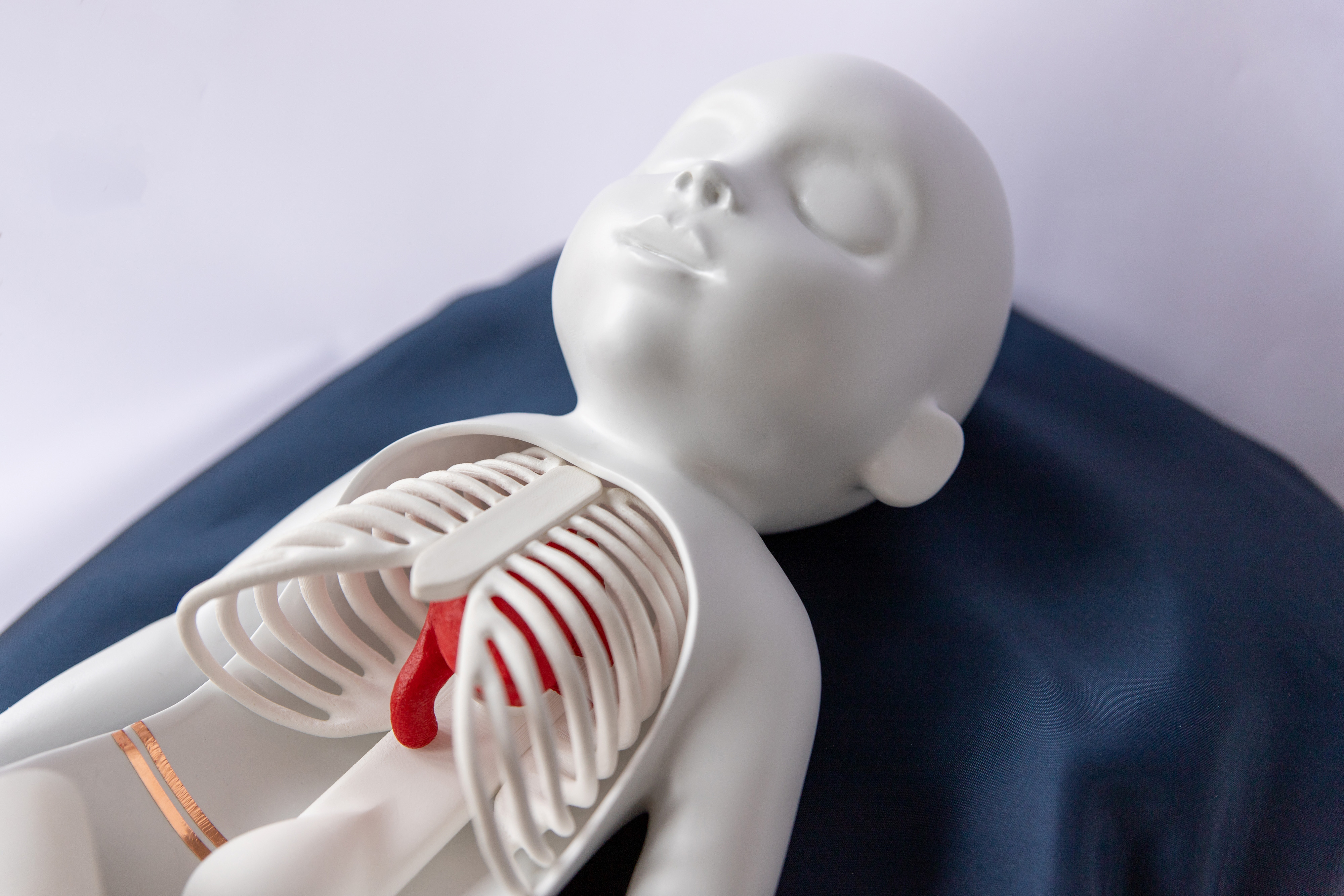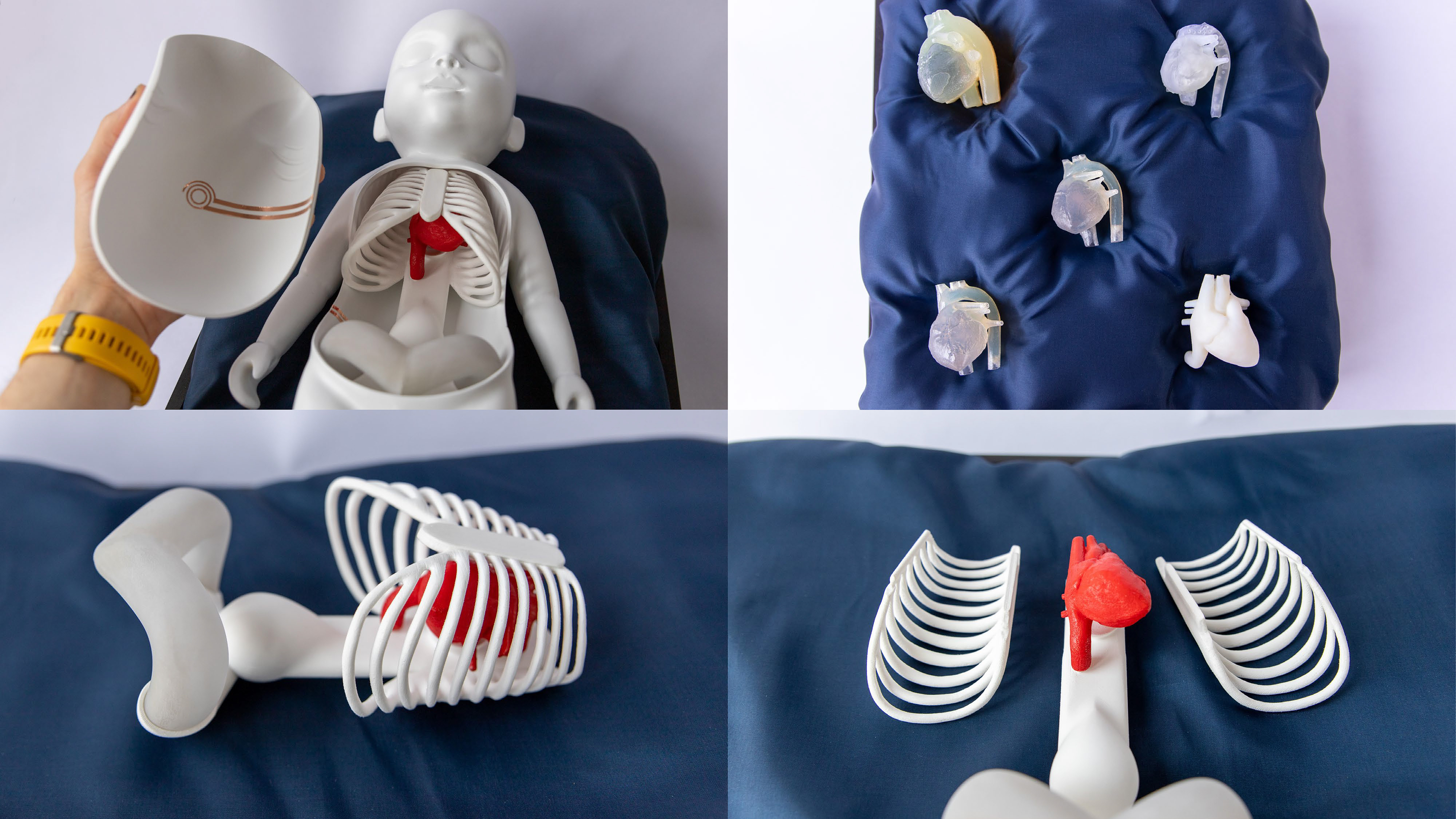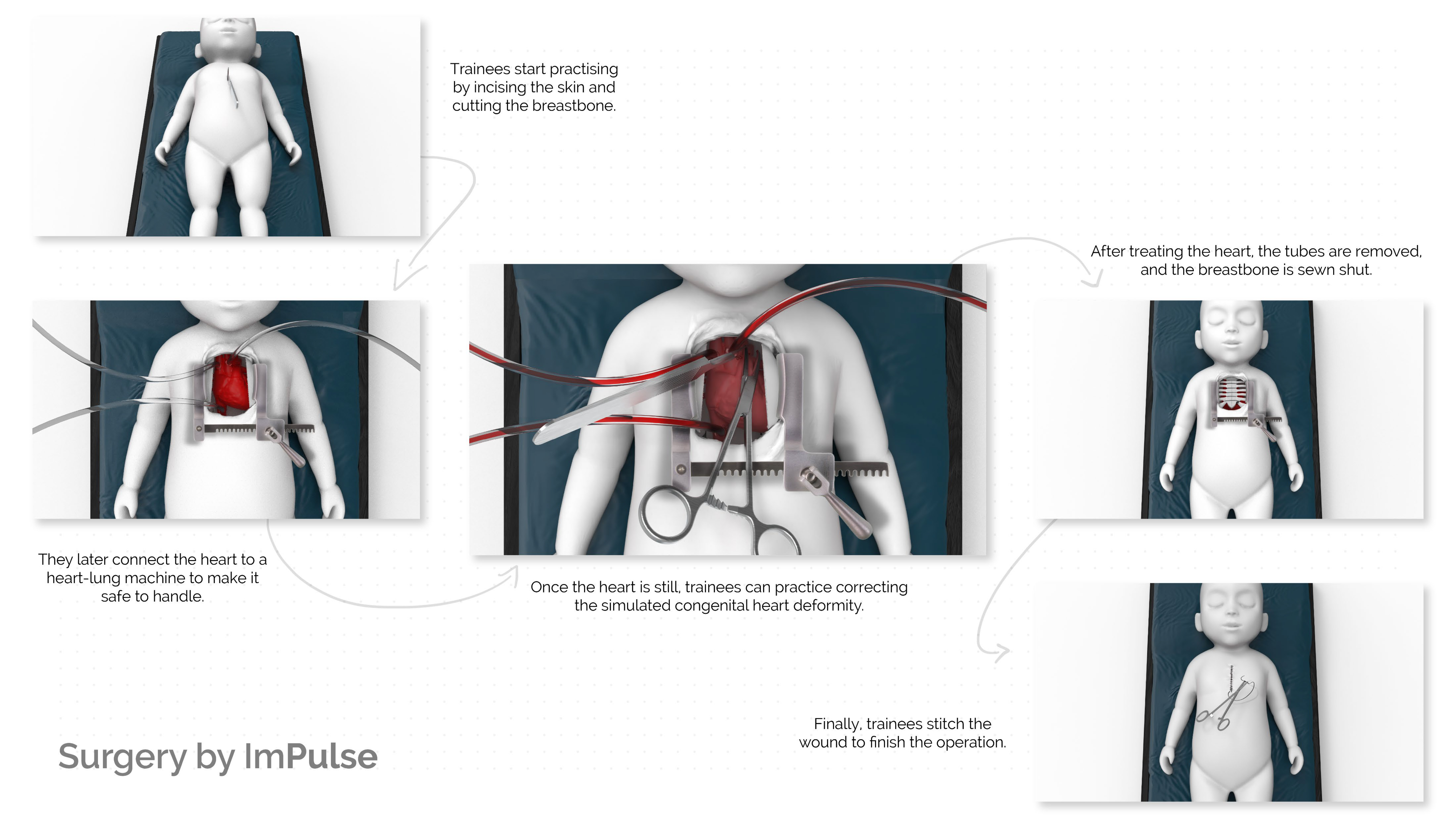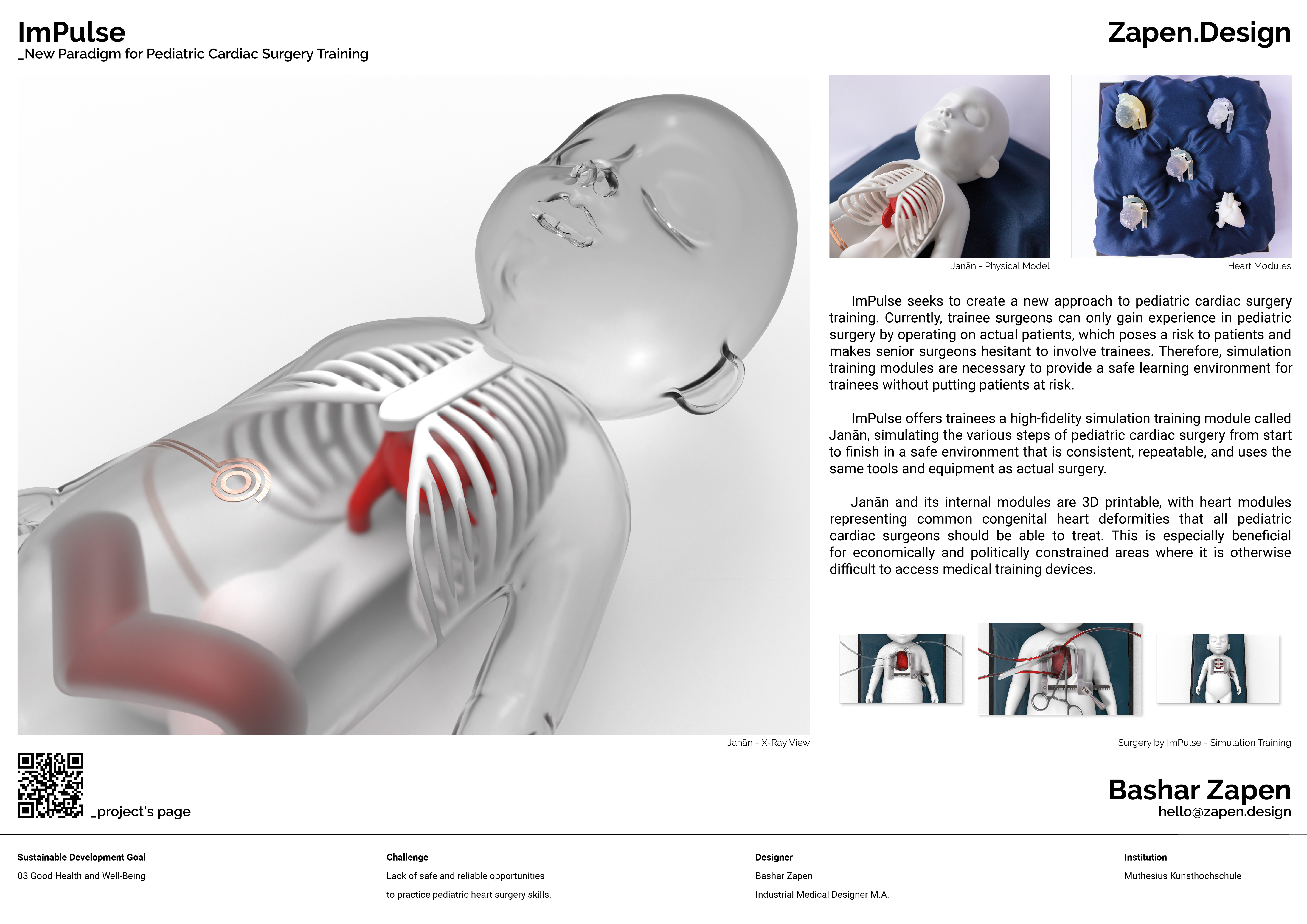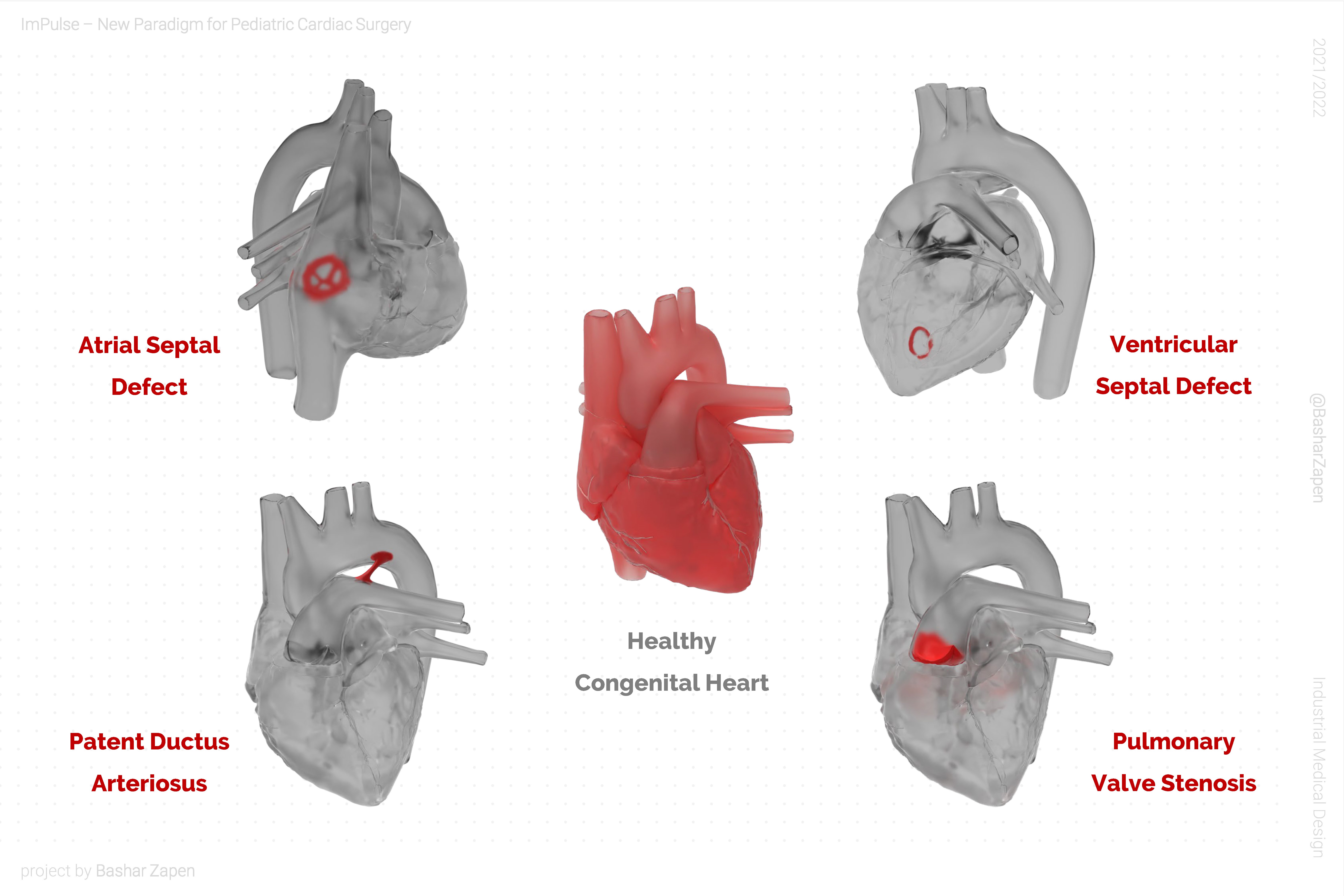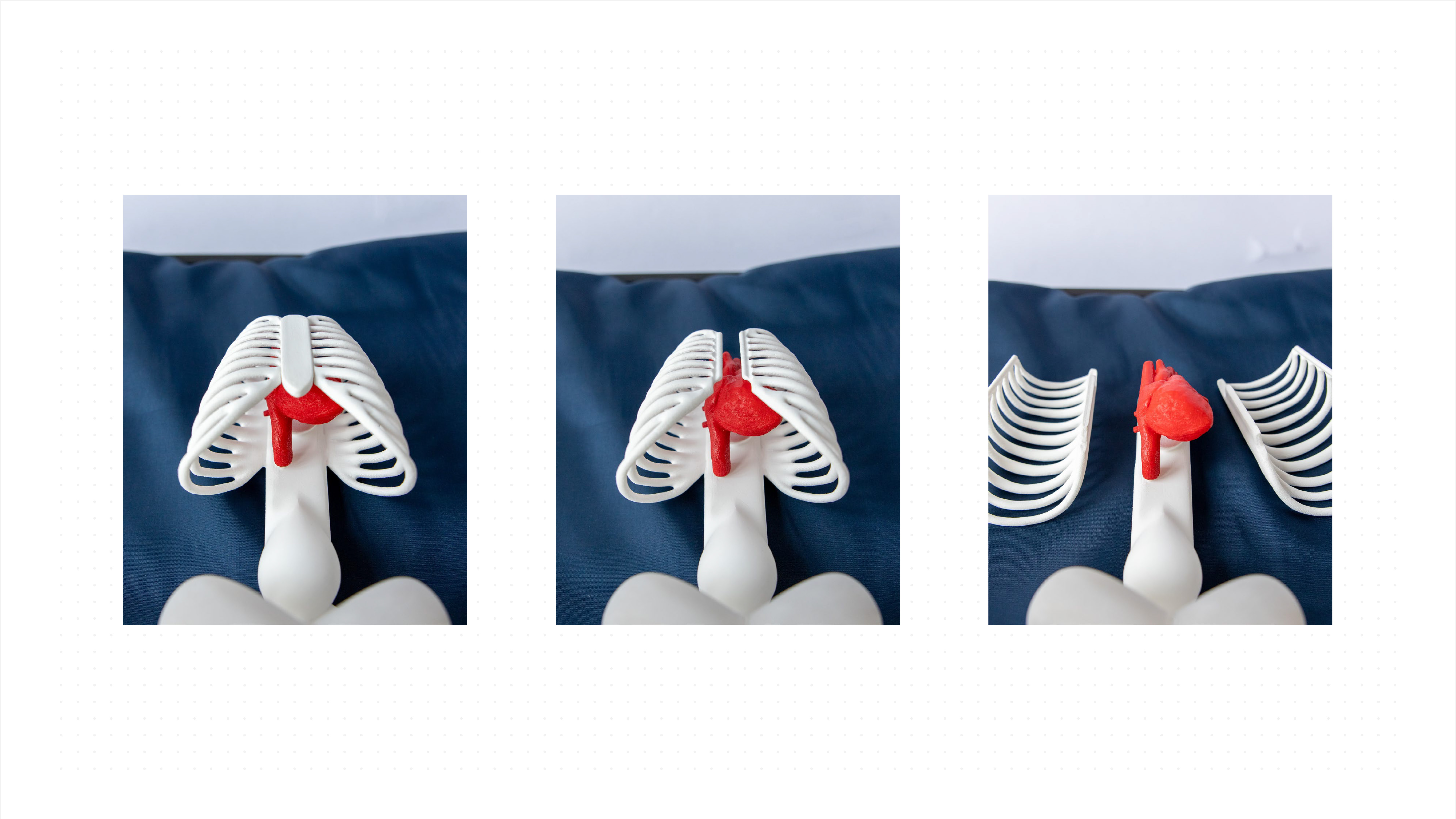Prioritising the places and people that need it the most
ImPulse
ImPulse - Simulation Training for Paediatric Cardiac Surgery
ImPulse revolutionizes pediatric cardiac surgery training with high-fidelity, 3D-printed simulation modules and Extended Reality (XR) overlays. Designed for ethical, cost-effective, and scalable hands-on practice, ImPulse accelerates surgical training while eliminating reliance on live patients and animal testing. By merging physical realism with future digital guidance, ImPulse ensures the next generation of surgeons can train safely, efficiently, and globally.
Germany
National
Mainly urban
It refers to other types of transformations (soft investment)
Prototype level
No
No
As an individual
ImPulse transforms pediatric cardiac surgery training by providing high-fidelity, 3D-printed simulation modules integrated with Extended Reality (XR). It offers a sustainable, scalable, and ethical alternative to traditional training and addresses the global shortage of skilled pediatric cardiac surgeons.
Target Group(s):
- Pediatric cardiac surgery trainees,
- Medical educators and institutions,
- Hospitals and surgical training centres,
- Underserved regions with limited surgical training opportunities.
Specific Objectives:
- Provide anatomically accurate, patient-specific heart models for hands-on surgical training,
- Eliminate the reliance on live patients and animal-harvested organs,
- Integrate XR overlays for real-time procedural guidance,
- Improve accessibility and affordability of advanced surgical training worldwide.
Achieved Outcomes:
- Creation of modular, reusable, and customizable training tools validated through pilot studies,
- Recognition through prestigious design and medical innovation awards,
- Interest from global institutions, positioning ImPulse for broader adoption.
New European Bauhaus Values & Working Principles:
Sustainability: Reduces medical training’s reliance on unethical and unsustainable resources, fostering responsible innovation.
Aesthetics & Functionality: Merges medical accuracy with a human-centred, ergonomic design to optimize training efficiency.
Inclusion: Democratizes access to high-quality surgical education, particularly in underfunded regions, ensuring equitable healthcare improvements.
Impact on Communities & Territories:
ImPulse addresses the urgent need for specialized surgical training in Germany, Europe, and beyond, especially in underserved regions with high rates of congenital heart disease. By making advanced training tools accessible, ImPulse improves surgical outcomes, strengthens healthcare infrastructures, and fosters medical self-sufficiency in resource-limited areas.
Target Group(s):
- Pediatric cardiac surgery trainees,
- Medical educators and institutions,
- Hospitals and surgical training centres,
- Underserved regions with limited surgical training opportunities.
Specific Objectives:
- Provide anatomically accurate, patient-specific heart models for hands-on surgical training,
- Eliminate the reliance on live patients and animal-harvested organs,
- Integrate XR overlays for real-time procedural guidance,
- Improve accessibility and affordability of advanced surgical training worldwide.
Achieved Outcomes:
- Creation of modular, reusable, and customizable training tools validated through pilot studies,
- Recognition through prestigious design and medical innovation awards,
- Interest from global institutions, positioning ImPulse for broader adoption.
New European Bauhaus Values & Working Principles:
Sustainability: Reduces medical training’s reliance on unethical and unsustainable resources, fostering responsible innovation.
Aesthetics & Functionality: Merges medical accuracy with a human-centred, ergonomic design to optimize training efficiency.
Inclusion: Democratizes access to high-quality surgical education, particularly in underfunded regions, ensuring equitable healthcare improvements.
Impact on Communities & Territories:
ImPulse addresses the urgent need for specialized surgical training in Germany, Europe, and beyond, especially in underserved regions with high rates of congenital heart disease. By making advanced training tools accessible, ImPulse improves surgical outcomes, strengthens healthcare infrastructures, and fosters medical self-sufficiency in resource-limited areas.
MedTech
Surgical Training [Simulation Training]
Sustainability
3D Printing and Extended Reality
Healthcare Accessibility
1. Reducing Reliance on Live-Patients and Animal-Based Training
Objective: Replace traditional surgical training methods that rely on live patients, cadavers, or animal-harvested organs, which raise ethical concerns and have a high environmental impact.
Achievement: ImPulse's 3D-printed heart modules, based on patient-specific MRI and CT data, eliminate the need for biological specimens, reduce biomedical waste and make training more sustainable.
2. Reusable, Scalable, and Cost-Effective Simulation Modules
Objective: Develop durable, reusable training tools to minimize resource consumption while ensuring widespread access to high-quality medical education.
Achievement: ImPulse’s modular design enables repeated use, drastically reducing material waste compared to single-use biological specimens and ensuring long-term economic feasibility.
3. Ethical and Inclusive Training for All Regions
Objective: Ensure global accessibility, particularly in regions with limited resources, to bridge the gap in pediatric cardiac surgery training.
Achievement: ImPulse democratizes access to medical training by offering a scalable, cost-effective alternative that can be deployed in both developed and underserved healthcare systems.
4. Sustainable Production through Additive Manufacturing
Objective: Utilize low-waste, on-demand 3D printing technologies to produce high-fidelity surgical training modules.
Achievement: The use of additive manufacturing minimizes material waste and transportation emissions, creating an environmentally conscious solution.
ImPulse exemplifies how medical innovation can align with sustainability principles by fostering ethical, low-impact, and scalable training solutions. By removing traditional methods' ethical and logistical barriers and replacing them with a modular, technology-driven alternative, ImPulse represents a future-proof model for medical education that can be adapted across disciplines and regions.
Objective: Replace traditional surgical training methods that rely on live patients, cadavers, or animal-harvested organs, which raise ethical concerns and have a high environmental impact.
Achievement: ImPulse's 3D-printed heart modules, based on patient-specific MRI and CT data, eliminate the need for biological specimens, reduce biomedical waste and make training more sustainable.
2. Reusable, Scalable, and Cost-Effective Simulation Modules
Objective: Develop durable, reusable training tools to minimize resource consumption while ensuring widespread access to high-quality medical education.
Achievement: ImPulse’s modular design enables repeated use, drastically reducing material waste compared to single-use biological specimens and ensuring long-term economic feasibility.
3. Ethical and Inclusive Training for All Regions
Objective: Ensure global accessibility, particularly in regions with limited resources, to bridge the gap in pediatric cardiac surgery training.
Achievement: ImPulse democratizes access to medical training by offering a scalable, cost-effective alternative that can be deployed in both developed and underserved healthcare systems.
4. Sustainable Production through Additive Manufacturing
Objective: Utilize low-waste, on-demand 3D printing technologies to produce high-fidelity surgical training modules.
Achievement: The use of additive manufacturing minimizes material waste and transportation emissions, creating an environmentally conscious solution.
ImPulse exemplifies how medical innovation can align with sustainability principles by fostering ethical, low-impact, and scalable training solutions. By removing traditional methods' ethical and logistical barriers and replacing them with a modular, technology-driven alternative, ImPulse represents a future-proof model for medical education that can be adapted across disciplines and regions.
Design objectives:
Human-Centered Design for Surgical Training: Develop an intuitive, tactile, and anatomically accurate simulation experience that enhances learning and skill acquisition.
Merging Physical & Digital Design: Integrate high-fidelity 3D-printed heart modules with Extended Reality (XR) overlays to create an immersive, interactive training environment.
Ergonomic & Realistic Training Interface: Ensure the simulation modules provide a high-quality sensory experience that mimics real surgical conditions, fostering precision and confidence.
Cultural Accessibility & Adaptability: Design the system for use across diverse training environments, from leading European medical institutions to resource-limited hospitals worldwide.
Aesthetic & Functional Integration: Balance form and function to create an innovative yet approachable tool that bridges the gap between technology, medical education, and cultural inclusivity.
Achievements:
Tactile Fidelity: ImPulse heart modules accurately replicate the texture, elasticity, and structure of pediatric cardiac tissues, providing medical students with a hands-on experience that enhances essential surgical skill development.
Inclusive Design Principles: ImPulse is designed for both expert surgeons and trainees, ensuring accessibility through modular difficulty levels and customizable training scenarios to address various patient cases.
Cross-Cultural & Global Adaptation: By making high-quality surgical training accessible to both well-funded and under-resourced regions, ImPulse fosters equitable medical education and skill-building worldwide.
Award-Winning Design Recognition: ImPulse has received prestigious accolades, such as the Red Dot Design Award and iF Design Award, demonstrating excellence in aesthetic quality, innovation, and usability.
Human-Centered Design for Surgical Training: Develop an intuitive, tactile, and anatomically accurate simulation experience that enhances learning and skill acquisition.
Merging Physical & Digital Design: Integrate high-fidelity 3D-printed heart modules with Extended Reality (XR) overlays to create an immersive, interactive training environment.
Ergonomic & Realistic Training Interface: Ensure the simulation modules provide a high-quality sensory experience that mimics real surgical conditions, fostering precision and confidence.
Cultural Accessibility & Adaptability: Design the system for use across diverse training environments, from leading European medical institutions to resource-limited hospitals worldwide.
Aesthetic & Functional Integration: Balance form and function to create an innovative yet approachable tool that bridges the gap between technology, medical education, and cultural inclusivity.
Achievements:
Tactile Fidelity: ImPulse heart modules accurately replicate the texture, elasticity, and structure of pediatric cardiac tissues, providing medical students with a hands-on experience that enhances essential surgical skill development.
Inclusive Design Principles: ImPulse is designed for both expert surgeons and trainees, ensuring accessibility through modular difficulty levels and customizable training scenarios to address various patient cases.
Cross-Cultural & Global Adaptation: By making high-quality surgical training accessible to both well-funded and under-resourced regions, ImPulse fosters equitable medical education and skill-building worldwide.
Award-Winning Design Recognition: ImPulse has received prestigious accolades, such as the Red Dot Design Award and iF Design Award, demonstrating excellence in aesthetic quality, innovation, and usability.
Inclusion objectives:
Accessibility in Medical Training: Provide an equitable, hands-on surgical training tool that is available to medical trainees regardless of geographic, economic, or institutional limitations.
Affordability & Scalability: Develop a cost-effective alternative to traditional live patient or animal-based training, ensuring that underfunded institutions and underserved regions can implement high-quality surgical education.
Design for All: Create modular, customizable training models that cater to different skill levels, making the system adaptable for novice trainees and experienced surgeons alike.
Ethical & Culturally Inclusive Training: Offer a non-invasive, universally accepted training method that respects ethical, cultural, and religious considerations related to medical education and surgical practice.
Achievements:
Affordable & Scalable: ImPulse’s 3D-printed modules drastically reduce the costs associated with surgical training, eliminating the need for expensive cadaveric specimens or live patient cases.
Global Reach & Adaptability: The system is designed for both high-tech training centres and low-resource medical institutions, ensuring equitable access to advanced training methods.
Ethical Training for Diverse Communities: By replacing animal-harvested organs with live patient training, ImPulse aligns with ethical standards and cultural sensitivities worldwide, creating an inclusive solution across different healthcare systems.
Customizable Learning Pathways: The modular design allows trainees to focus on specific congenital heart conditions, adapting the training to their local and institutional needs.
Collaborative Innovation Model: ImPulse has received interest from institutions in Europe, the Middle East, and underserved regions, highlighting its ability to bridge gaps in medical education across different territories.
Accessibility in Medical Training: Provide an equitable, hands-on surgical training tool that is available to medical trainees regardless of geographic, economic, or institutional limitations.
Affordability & Scalability: Develop a cost-effective alternative to traditional live patient or animal-based training, ensuring that underfunded institutions and underserved regions can implement high-quality surgical education.
Design for All: Create modular, customizable training models that cater to different skill levels, making the system adaptable for novice trainees and experienced surgeons alike.
Ethical & Culturally Inclusive Training: Offer a non-invasive, universally accepted training method that respects ethical, cultural, and religious considerations related to medical education and surgical practice.
Achievements:
Affordable & Scalable: ImPulse’s 3D-printed modules drastically reduce the costs associated with surgical training, eliminating the need for expensive cadaveric specimens or live patient cases.
Global Reach & Adaptability: The system is designed for both high-tech training centres and low-resource medical institutions, ensuring equitable access to advanced training methods.
Ethical Training for Diverse Communities: By replacing animal-harvested organs with live patient training, ImPulse aligns with ethical standards and cultural sensitivities worldwide, creating an inclusive solution across different healthcare systems.
Customizable Learning Pathways: The modular design allows trainees to focus on specific congenital heart conditions, adapting the training to their local and institutional needs.
Collaborative Innovation Model: ImPulse has received interest from institutions in Europe, the Middle East, and underserved regions, highlighting its ability to bridge gaps in medical education across different territories.
The ImPulse project has been deeply shaped by the direct involvement of healthcare professionals, patients, and civil society organizations, ensuring that the solution is not only technically effective but also meets the real needs of the communities it aims to serve.
1. Medical Experts & Trainees: The project was developed through interviews with leading pediatric cardiac surgeons (Dr Kerr, Dr Al-Azab, Prof. Haj-Yahia, and Dr Tarek Loubani), who provided insights into the limitations of current surgical training and validated the need for high-fidelity simulation modules. These experts also helped refine the design of the training models to ensure medical accuracy and usability.
2. Civil Society & NGOs: Organizations like the Palestine Children's Relief Fund (PCRF) and Médecins Sans Frontières (MSF) have contributed crucial perspectives on the medical training challenges in underserved regions. Their involvement has guided the project’s focus on accessibility and scalability, particularly for areas with weak healthcare infrastructure.
3. Community-Led Design: The project integrates feedback from local medical students and young doctors from Kiel's University Hospital (UKSH), ensuring that the training modules align with their needs and learning styles. This participatory approach helps make ImPulse more effective and adaptable to different training environments.
4. Impact of Citizen & Civil Society Involvement:
- Refined Training Models: Continuous feedback from German surgeons and trainees improved the simulation modules' anatomical accuracy and tactile fidelity.
- Increased Accessibility: Discussions with NGOs highlighted the need for cost-effective, modular designs that ensure ImPulse can be implemented in underfunded hospitals.
- Expanded Reach: Civil society organizations facilitated connections with medical institutions across Europe and the Middle East, broadening ImPulse’s potential impact.
1. Medical Experts & Trainees: The project was developed through interviews with leading pediatric cardiac surgeons (Dr Kerr, Dr Al-Azab, Prof. Haj-Yahia, and Dr Tarek Loubani), who provided insights into the limitations of current surgical training and validated the need for high-fidelity simulation modules. These experts also helped refine the design of the training models to ensure medical accuracy and usability.
2. Civil Society & NGOs: Organizations like the Palestine Children's Relief Fund (PCRF) and Médecins Sans Frontières (MSF) have contributed crucial perspectives on the medical training challenges in underserved regions. Their involvement has guided the project’s focus on accessibility and scalability, particularly for areas with weak healthcare infrastructure.
3. Community-Led Design: The project integrates feedback from local medical students and young doctors from Kiel's University Hospital (UKSH), ensuring that the training modules align with their needs and learning styles. This participatory approach helps make ImPulse more effective and adaptable to different training environments.
4. Impact of Citizen & Civil Society Involvement:
- Refined Training Models: Continuous feedback from German surgeons and trainees improved the simulation modules' anatomical accuracy and tactile fidelity.
- Increased Accessibility: Discussions with NGOs highlighted the need for cost-effective, modular designs that ensure ImPulse can be implemented in underfunded hospitals.
- Expanded Reach: Civil society organizations facilitated connections with medical institutions across Europe and the Middle East, broadening ImPulse’s potential impact.
1. Local Level
Healthcare Professionals & Trainees: Direct interviews with pediatric cardiac surgeons and medical trainees in Gaza and Germany provided critical insights into the limitations of traditional surgical training and the need for affordable, ethical simulation models.
Local Civil Society & NGOs: Organizations such as the Palestine Children’s Relief Fund (PCRF) and Médecins Sans Frontières (MSF) helped shape the project’s accessibility and impact strategy, ensuring that ImPulse addresses real healthcare gaps in constrained environments.
2. Regional Level
Medical Institutions & Research Centers: ImPulse engaged with regional hospitals and universities to explore how simulation training can be integrated into pediatric cardiology curricula.
Humanitarian Organizations: Collaborations with aid groups and field hospitals have ensured the solution is tailored to resource-limited settings, making it feasible for training programs in conflict-affected regions.
3. National Level
German Medical Schools & Design Institutions: The project was developed as part of a master’s thesis at Muthesius Kunsthochschule, leveraging academic expertise in industrial and medical design.
R&D and Innovation Hubs: Collaboration with German and European research institutions has helped optimize ImPulse’s manufacturing, material selection, and extended reality (XR) integration.
4. European Level
EU Research & Innovation Networks: ImPulse has been aligned with EU sustainability and medical innovation initiatives, aiming to secure support from European medical simulation funding programs.
Healthcare Professionals & Trainees: Direct interviews with pediatric cardiac surgeons and medical trainees in Gaza and Germany provided critical insights into the limitations of traditional surgical training and the need for affordable, ethical simulation models.
Local Civil Society & NGOs: Organizations such as the Palestine Children’s Relief Fund (PCRF) and Médecins Sans Frontières (MSF) helped shape the project’s accessibility and impact strategy, ensuring that ImPulse addresses real healthcare gaps in constrained environments.
2. Regional Level
Medical Institutions & Research Centers: ImPulse engaged with regional hospitals and universities to explore how simulation training can be integrated into pediatric cardiology curricula.
Humanitarian Organizations: Collaborations with aid groups and field hospitals have ensured the solution is tailored to resource-limited settings, making it feasible for training programs in conflict-affected regions.
3. National Level
German Medical Schools & Design Institutions: The project was developed as part of a master’s thesis at Muthesius Kunsthochschule, leveraging academic expertise in industrial and medical design.
R&D and Innovation Hubs: Collaboration with German and European research institutions has helped optimize ImPulse’s manufacturing, material selection, and extended reality (XR) integration.
4. European Level
EU Research & Innovation Networks: ImPulse has been aligned with EU sustainability and medical innovation initiatives, aiming to secure support from European medical simulation funding programs.
Key Knowledge Fields & Their Role in ImPulse:
Medical Science & Pediatric Cardiac Surgery: Surgeons and medical trainees guided the anatomical accuracy, usability, and effectiveness of the simulation models.
Industrial & Medical Design: Ensured ergonomic, high-fidelity 3D-printed models that mimic real pediatric heart tissues for hands-on training.
Material Science & Additive Manufacturing: Identified flexible yet durable materials for realistic surgical practice while optimizing cost and sustainability.
Humanitarian & Public Health Policy – NGOs and civil society groups ensured accessibility in underserved regions, particularly in conflict-affected areas.
Interdisciplinary Collaboration & Added Value:
Cross-field Synergy: Surgeons, designers, and engineers co-created a solution that balances medical precision with design usability.
Technology Integration: Material scientists and engineers collaborated to develop realistic, cost-effective, and reusable surgical training tools.
Scalability & Accessibility: Collaboration with NGOs and policy experts helped bridge the gap between innovation and real-world implementation.
Medical Science & Pediatric Cardiac Surgery: Surgeons and medical trainees guided the anatomical accuracy, usability, and effectiveness of the simulation models.
Industrial & Medical Design: Ensured ergonomic, high-fidelity 3D-printed models that mimic real pediatric heart tissues for hands-on training.
Material Science & Additive Manufacturing: Identified flexible yet durable materials for realistic surgical practice while optimizing cost and sustainability.
Humanitarian & Public Health Policy – NGOs and civil society groups ensured accessibility in underserved regions, particularly in conflict-affected areas.
Interdisciplinary Collaboration & Added Value:
Cross-field Synergy: Surgeons, designers, and engineers co-created a solution that balances medical precision with design usability.
Technology Integration: Material scientists and engineers collaborated to develop realistic, cost-effective, and reusable surgical training tools.
Scalability & Accessibility: Collaboration with NGOs and policy experts helped bridge the gap between innovation and real-world implementation.
1. Eliminating Reliance on Live Patients & Animal Organs
Conventional training depends on opportunity-based learning, where trainees practice on actual patients or harvested animal organs. This limits the number of training opportunities and poses ethical concerns. ImPulse replaces these methods with high-fidelity 3D-printed simulation modules, ensuring consistent, risk-free, and repeatable training for aspiring pediatric cardiac surgeons.
2. Customizable & Patient-Specific Models
Traditional ways of designing Simulator Trainers are often rigid and standardized, failing to replicate the unique complexity of real congenital heart defects. ImPulse introduces patient-specific heart models generated from MRI/CT data, allowing trainees to rehearse surgeries on realistic, condition-specific simulations before performing on actual patients.
3. Sustainable & Ethical Medical Training
Many current training tools are single-use, resource-intensive, or dependent on imported cadaveric materials. ImPulse is designed to be reusable, modular, and cost-efficient, significantly reducing medical training waste and making high-quality simulation training affordable for low-resource hospitals and institutions.
4. Scalability for Global Medical Training
Existing surgical training programs are often confined to well-funded institutions, leaving surgeons in low-resource regions with limited access to hands-on practice. ImPulse breaks this barrier by offering low-cost manufacturing, easy distribution, and seamless integration into medical curricula worldwide, making it a scalable, high-impact solution.
Conventional training depends on opportunity-based learning, where trainees practice on actual patients or harvested animal organs. This limits the number of training opportunities and poses ethical concerns. ImPulse replaces these methods with high-fidelity 3D-printed simulation modules, ensuring consistent, risk-free, and repeatable training for aspiring pediatric cardiac surgeons.
2. Customizable & Patient-Specific Models
Traditional ways of designing Simulator Trainers are often rigid and standardized, failing to replicate the unique complexity of real congenital heart defects. ImPulse introduces patient-specific heart models generated from MRI/CT data, allowing trainees to rehearse surgeries on realistic, condition-specific simulations before performing on actual patients.
3. Sustainable & Ethical Medical Training
Many current training tools are single-use, resource-intensive, or dependent on imported cadaveric materials. ImPulse is designed to be reusable, modular, and cost-efficient, significantly reducing medical training waste and making high-quality simulation training affordable for low-resource hospitals and institutions.
4. Scalability for Global Medical Training
Existing surgical training programs are often confined to well-funded institutions, leaving surgeons in low-resource regions with limited access to hands-on practice. ImPulse breaks this barrier by offering low-cost manufacturing, easy distribution, and seamless integration into medical curricula worldwide, making it a scalable, high-impact solution.
1. Research & Problem Identification
The project began with an in-depth literature review on pediatric cardiac surgery training, identifying limitations in traditional learning methods such as opportunity-based training, ethical concerns, and lack of accessibility. Additionally, expert interviews with pediatric surgeons and humanitarian organizations provided real-world insights into the urgent need for alternative training solutions, particularly in underserved regions.
2. Human-Centered & Iterative Design Process
ImPulse follows a user-centered design approach, ensuring that the training modules meet the needs of trainees, educators, and medical institutions. The project adopted an iterative prototyping methodology, where multiple 3D-printed heart models were tested and refined based on feedback from surgeons and medical students. The design focused on anatomical accuracy, realistic tactile feedback, and modularity for repeated use.
3. Material Science & Additive Manufacturing
Through additive manufacturing (3D printing), the project developed high-fidelity, patient-specific heart models derived from MRI/CT data. This allows for precisely replicating congenital heart defects, providing a customizable and scalable training tool.
4. Ethical & Sustainable Implementation
To ensure accessibility, ImPulse was designed to be affordable, reusable, and adaptable for both high-tech training centres and low-resource settings. The use of locally available materials and open-source digital fabrication methods enables scalability even in constrained environments. Additionally, by eliminating the reliance on animal-harvested organs or cadaveric materials, ImPulse aligns with ethical medical training standards.
By integrating medical research, user-driven design, advanced manufacturing, and sustainability principles, ImPulse delivers a cost-effective, ethical, and high-impact solution for pediatric cardiac surgery training worldwide.
The project began with an in-depth literature review on pediatric cardiac surgery training, identifying limitations in traditional learning methods such as opportunity-based training, ethical concerns, and lack of accessibility. Additionally, expert interviews with pediatric surgeons and humanitarian organizations provided real-world insights into the urgent need for alternative training solutions, particularly in underserved regions.
2. Human-Centered & Iterative Design Process
ImPulse follows a user-centered design approach, ensuring that the training modules meet the needs of trainees, educators, and medical institutions. The project adopted an iterative prototyping methodology, where multiple 3D-printed heart models were tested and refined based on feedback from surgeons and medical students. The design focused on anatomical accuracy, realistic tactile feedback, and modularity for repeated use.
3. Material Science & Additive Manufacturing
Through additive manufacturing (3D printing), the project developed high-fidelity, patient-specific heart models derived from MRI/CT data. This allows for precisely replicating congenital heart defects, providing a customizable and scalable training tool.
4. Ethical & Sustainable Implementation
To ensure accessibility, ImPulse was designed to be affordable, reusable, and adaptable for both high-tech training centres and low-resource settings. The use of locally available materials and open-source digital fabrication methods enables scalability even in constrained environments. Additionally, by eliminating the reliance on animal-harvested organs or cadaveric materials, ImPulse aligns with ethical medical training standards.
By integrating medical research, user-driven design, advanced manufacturing, and sustainability principles, ImPulse delivers a cost-effective, ethical, and high-impact solution for pediatric cardiac surgery training worldwide.
1. Scalable Training Methodology
The human-centred, iterative design process used in ImPulse can be applied to other medical fields requiring hands-on procedural training. For example, 3D-printing patient-specific models based on MRI/CT data can be adapted for surgical training in neurology, orthopaedics, or general surgery, providing realistic and cost-effective alternatives to traditional training.
2. Adaptable 3D-Printed Simulation Models
The modular, reusable, and customizable nature of ImPulse makes it highly adaptable. The same digital workflow—from medical imaging to 3D-printed anatomical models—can be transferred to different hospitals, universities, and training institutions worldwide. Local production using open-source digital fabrication methods enables institutions in low-resource or conflict-affected areas to adopt the technology without relying on expensive imports.
3. Sustainable & Ethical Training Alternatives
The project’s use of biocompatible, durable materials and its elimination of reliance on live patients or animal organs can set a new standard for ethical medical training. This approach can be replicated in any medical education system seeking sustainable, low-cost solutions while maintaining high-quality surgical training.
4. Low-Cost Manufacturing & Distribution Model
Using affordable 3D printing technologies and locally sourced materials, ImPulse can be easily replicated in hospitals, medical schools, and simulation labs worldwide. The digital design files can be shared openly, allowing other institutions to fabricate their own models with minimal cost.
The human-centred, iterative design process used in ImPulse can be applied to other medical fields requiring hands-on procedural training. For example, 3D-printing patient-specific models based on MRI/CT data can be adapted for surgical training in neurology, orthopaedics, or general surgery, providing realistic and cost-effective alternatives to traditional training.
2. Adaptable 3D-Printed Simulation Models
The modular, reusable, and customizable nature of ImPulse makes it highly adaptable. The same digital workflow—from medical imaging to 3D-printed anatomical models—can be transferred to different hospitals, universities, and training institutions worldwide. Local production using open-source digital fabrication methods enables institutions in low-resource or conflict-affected areas to adopt the technology without relying on expensive imports.
3. Sustainable & Ethical Training Alternatives
The project’s use of biocompatible, durable materials and its elimination of reliance on live patients or animal organs can set a new standard for ethical medical training. This approach can be replicated in any medical education system seeking sustainable, low-cost solutions while maintaining high-quality surgical training.
4. Low-Cost Manufacturing & Distribution Model
Using affordable 3D printing technologies and locally sourced materials, ImPulse can be easily replicated in hospitals, medical schools, and simulation labs worldwide. The digital design files can be shared openly, allowing other institutions to fabricate their own models with minimal cost.
ImPulse was inspired in 2021 by Gaza’s lack of pediatric cardiac surgeons and severe medical import restrictions...
1. Addressing the Global Shortage of Pediatric Cardiac Surgeons
Congenital heart diseases (CHDs) are a leading cause of infant mortality worldwide, yet many low-resource regions lack trained pediatric cardiac surgeons. In places like Palestine and Sub-Saharan Africa, medical trainees have few opportunities for hands-on practice, as surgeries are often outsourced to foreign hospitals or visiting humanitarian missions. ImPulse provides an in-country, sustainable training solution, allowing local medical professionals to develop expertise without relying on external aid.
2. Overcoming Training Barriers in Conflict & Resource-Limited Zones
In Gaza, where medical infrastructure is severely restricted [now decimated], and in parts of Africa facing similar economic and political challenges, access to cadaveric training, imported medical devices, and advanced surgical simulations is nearly impossible. ImPulse circumvents these barriers by offering 3D-printed, patient-specific heart models, allowing trainees to develop life-saving skills using locally available resources.
3. Creating Ethical & Sustainable Alternatives
In many training centres worldwide, the surgical practice relies on live patients or animal-harvested organs, raising ethical and logistical concerns. ImPulse eliminates these challenges by offering a reusable, high-fidelity, and anatomically accurate alternative that can be locally manufactured cheaply, reducing dependency on imports and humanitarian aid.
4. Strengthening Local Healthcare Systems
ImPulse helps build self-sufficient medical education systems in Palestine, Africa, and beyond by enabling local hospitals and universities to implement independent, high-quality training. Over time, this contributes to better-trained surgeons, improved patient outcomes, and reduced reliance on costly overseas treatments.
1. Addressing the Global Shortage of Pediatric Cardiac Surgeons
Congenital heart diseases (CHDs) are a leading cause of infant mortality worldwide, yet many low-resource regions lack trained pediatric cardiac surgeons. In places like Palestine and Sub-Saharan Africa, medical trainees have few opportunities for hands-on practice, as surgeries are often outsourced to foreign hospitals or visiting humanitarian missions. ImPulse provides an in-country, sustainable training solution, allowing local medical professionals to develop expertise without relying on external aid.
2. Overcoming Training Barriers in Conflict & Resource-Limited Zones
In Gaza, where medical infrastructure is severely restricted [now decimated], and in parts of Africa facing similar economic and political challenges, access to cadaveric training, imported medical devices, and advanced surgical simulations is nearly impossible. ImPulse circumvents these barriers by offering 3D-printed, patient-specific heart models, allowing trainees to develop life-saving skills using locally available resources.
3. Creating Ethical & Sustainable Alternatives
In many training centres worldwide, the surgical practice relies on live patients or animal-harvested organs, raising ethical and logistical concerns. ImPulse eliminates these challenges by offering a reusable, high-fidelity, and anatomically accurate alternative that can be locally manufactured cheaply, reducing dependency on imports and humanitarian aid.
4. Strengthening Local Healthcare Systems
ImPulse helps build self-sufficient medical education systems in Palestine, Africa, and beyond by enabling local hospitals and universities to implement independent, high-quality training. Over time, this contributes to better-trained surgeons, improved patient outcomes, and reduced reliance on costly overseas treatments.
In the year following the application, ImPulse will focus on refinement, validation, and integration into European medical training programs while establishing partnerships for broader adoption.
1. Finalizing the Minimum Viable Product (MVP)
- Improve 3D-printed heart models to enhance anatomical accuracy and usability.
- Conduct usability tests with German and European medical institutions to refine the design.
- Develop a cost-effective, scalable manufacturing process within Europe.
2. Clinical Validation & Institutional Integration
- Partner with German and European medical schools and hospitals to integrate ImPulse into surgical training curricula.
- Conduct clinical trials in European training centres to validate effectiveness.
- Collaborate with surgical education boards to align ImPulse with certification and training standards.
3. Funding & Strategic Partnerships
- Apply for EU research grants and innovation funding to support further development.
- Engage with universities, research labs, and industry partners for co-development and commercialization.
- Promote ImPulse through medical technology conferences, European innovation hubs, and research publications.
4. Scaling & European Market Entry
- Launch pilot programs in German and European hospitals to demonstrate impact.
- Establish partnerships with medical device companies and simulation centres for broader distribution.
- Explore policy adoption with European medical associations to integrate ImPulse into standardized surgical training programs.
ImPulse aims to become a recognized surgical training tool in Germany and Europe. By initially focusing on validation, funding, and institutional partnerships, it will be positioned to set a new standard for ethical, cost-effective, and high-fidelity medical education.
1. Finalizing the Minimum Viable Product (MVP)
- Improve 3D-printed heart models to enhance anatomical accuracy and usability.
- Conduct usability tests with German and European medical institutions to refine the design.
- Develop a cost-effective, scalable manufacturing process within Europe.
2. Clinical Validation & Institutional Integration
- Partner with German and European medical schools and hospitals to integrate ImPulse into surgical training curricula.
- Conduct clinical trials in European training centres to validate effectiveness.
- Collaborate with surgical education boards to align ImPulse with certification and training standards.
3. Funding & Strategic Partnerships
- Apply for EU research grants and innovation funding to support further development.
- Engage with universities, research labs, and industry partners for co-development and commercialization.
- Promote ImPulse through medical technology conferences, European innovation hubs, and research publications.
4. Scaling & European Market Entry
- Launch pilot programs in German and European hospitals to demonstrate impact.
- Establish partnerships with medical device companies and simulation centres for broader distribution.
- Explore policy adoption with European medical associations to integrate ImPulse into standardized surgical training programs.
ImPulse aims to become a recognized surgical training tool in Germany and Europe. By initially focusing on validation, funding, and institutional partnerships, it will be positioned to set a new standard for ethical, cost-effective, and high-fidelity medical education.

